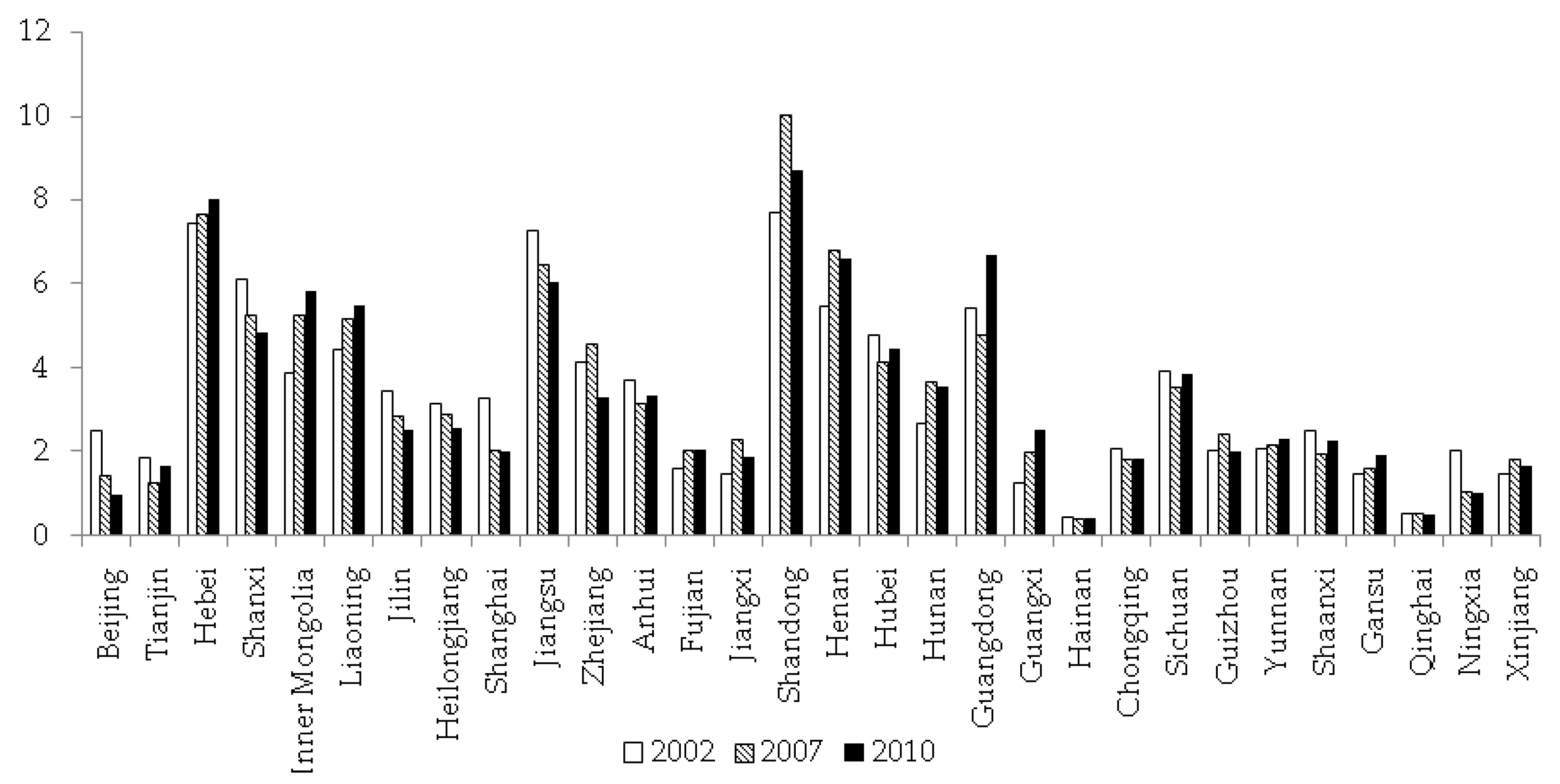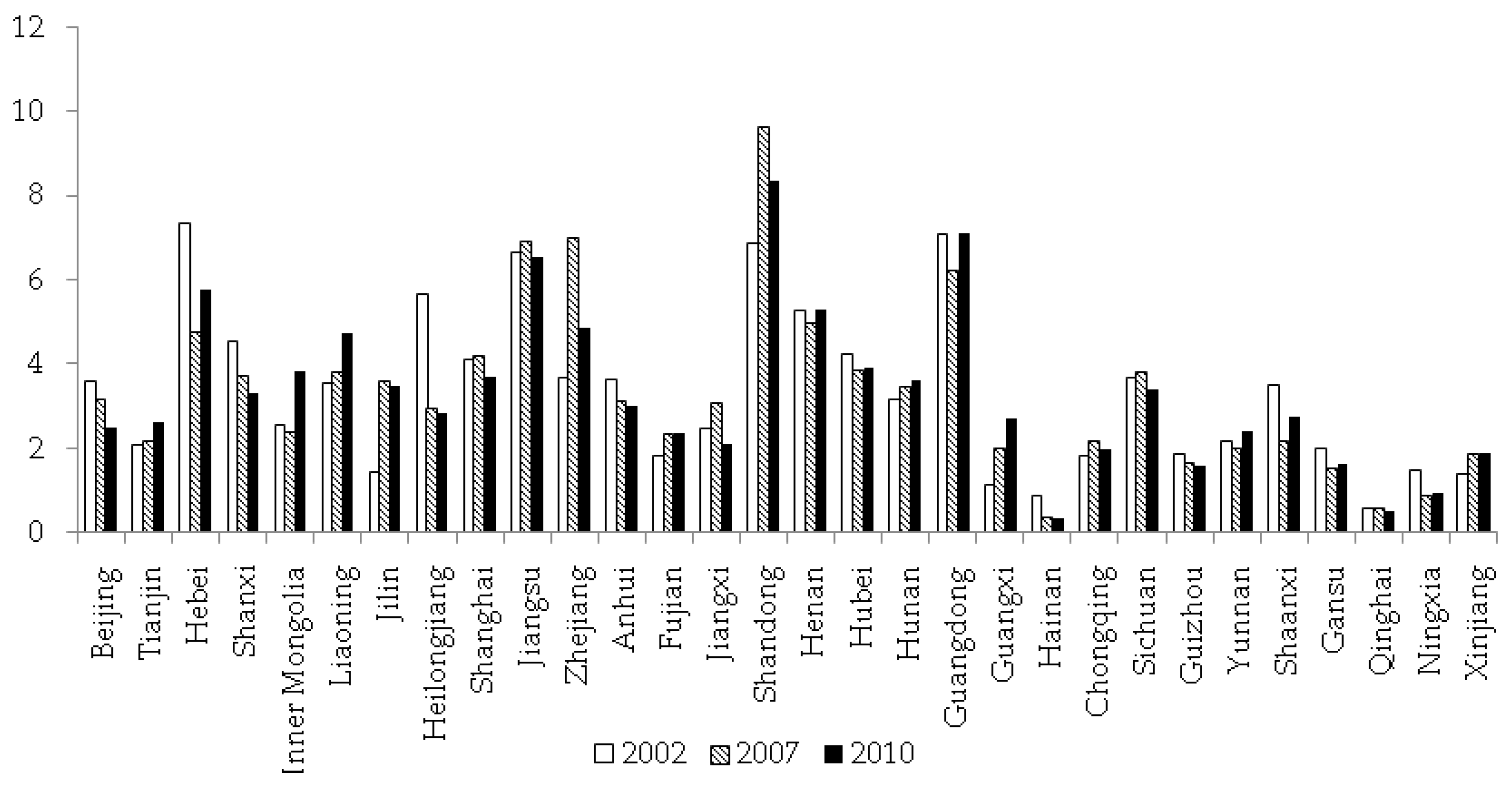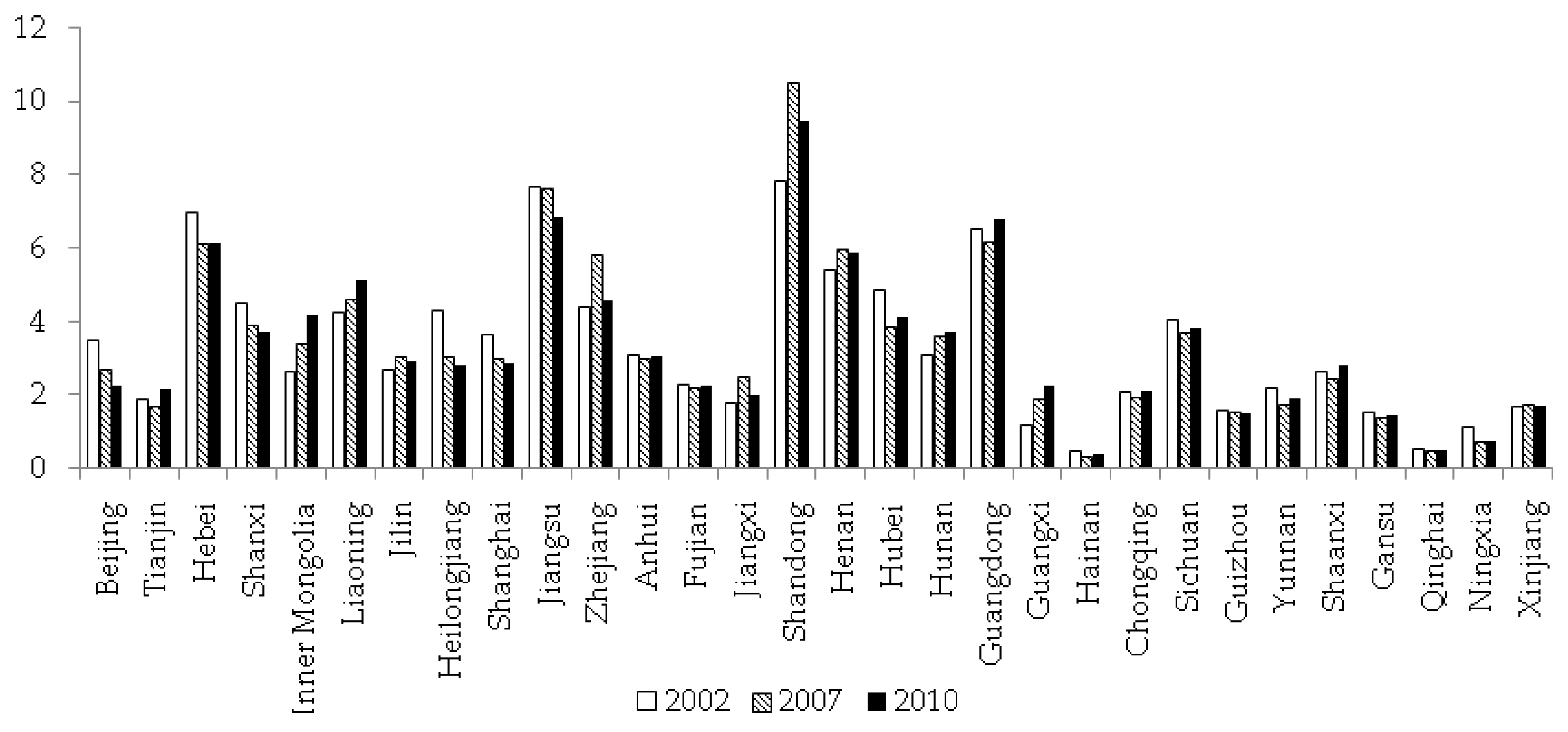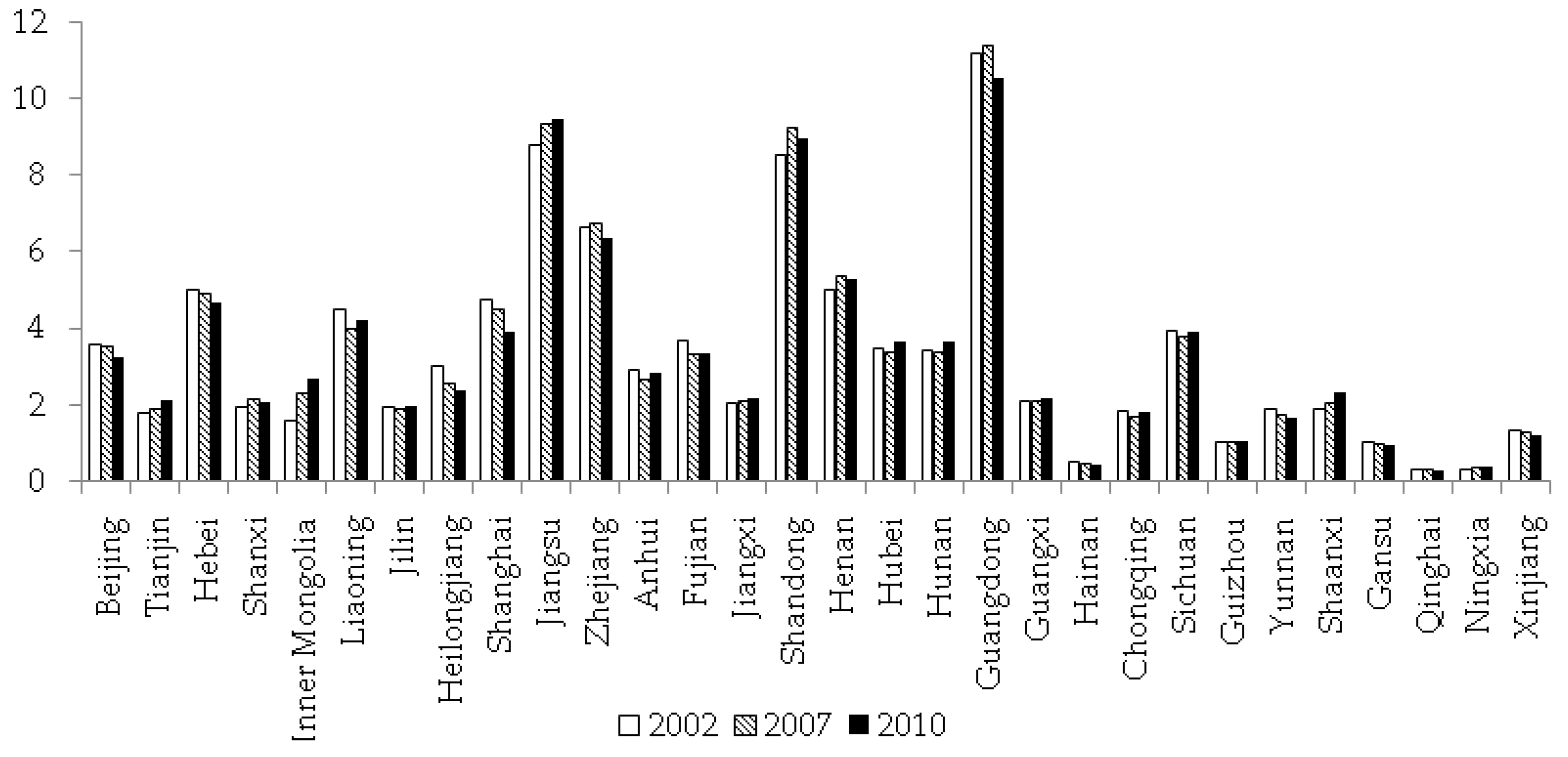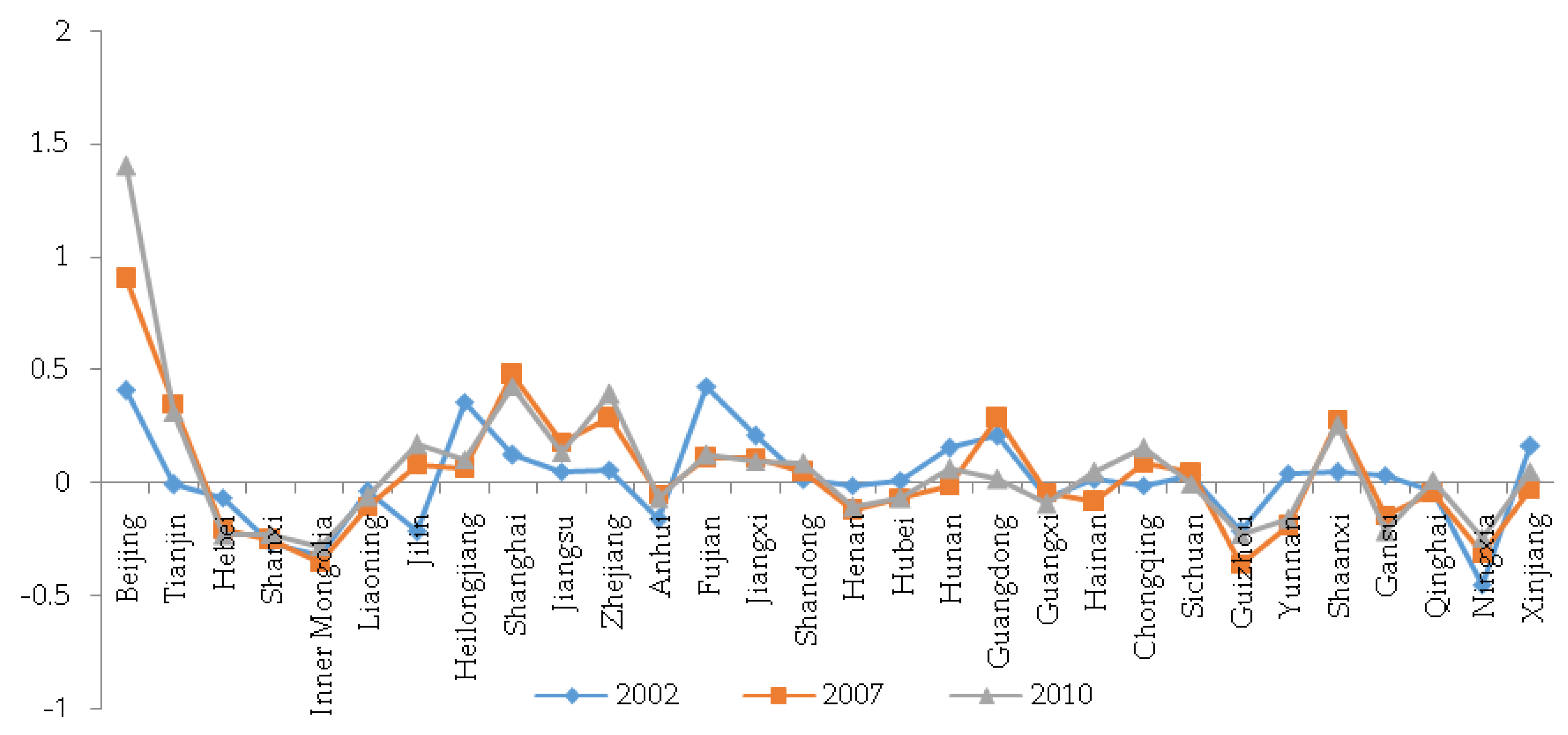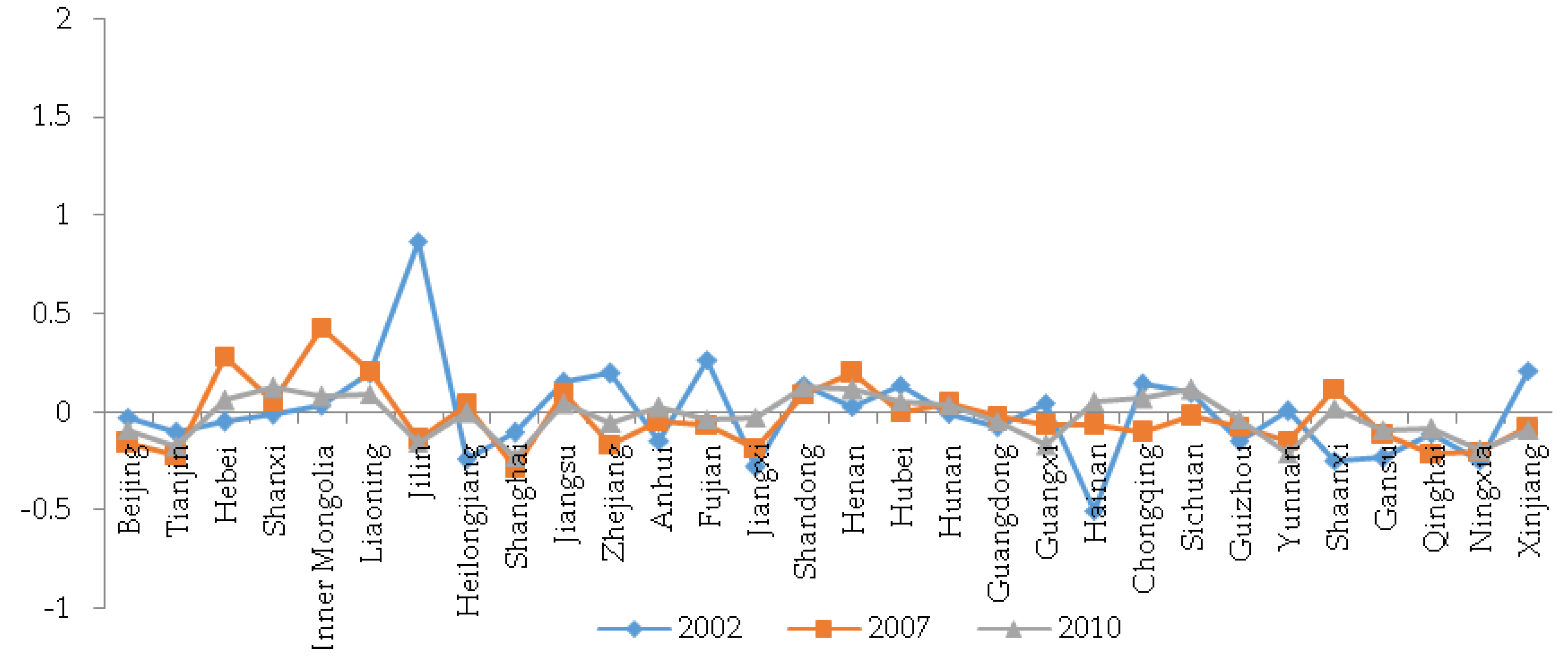1. Introduction
The State Council issued the “13th Five-Year” program to control greenhouse gas emissions on October 2016, which proposed that CO2 emissions per unit GDP (Gross Domestic Product) should be cut by 18% from the 2015 levels by 2020. Additionally, the national carbon emissions rights trading market will be launched by 2017. It means that all provinces will be included in a trading system to achieve the carbon reduction targets. Therefore, it is critical to determine the reasonable shares of carbon emissions responsibilities and rights. If one divides the carbon emissions reduction responsibility and carbon emissions rights totally in accordance with the principles of production, consumption, or some shared responsibility based on production and consumption principles, it may involve issues such as fairness and efficiency. In addition to promoting the coordinated development of economic growth in China, the separation of production and consumption places implies inter-provincial carbon emissions transfer. Moreover, the great differences in the provincial economic development levels, industrial structures, and natural conditions and other economic development conditions may result in different capacities to bear the carbon emissions reduction responsibility among provinces. Therefore, from the perspective of the provincial value chain, this study makes use of the economic link directly and indirectly among sectors in input-output tables, and tracks the value captured by all participants in the production chain and the amount of carbon emissions, thus allocating their corresponding carbon emissions reduction responsibilities in accordance with their abilities. This is propitious to determining reasonable carbon emissions reduction measures, scientifically allocating carbon emissions reduction responsibilities, and providing theoretical support for the realization of carbon emissions reduction targets and the establishment of a carbon emissions trading system.
Domestic and foreign scholars conducted a series of studies on the principles of carbon emissions responsibilities. The earliest is the principles of historical responsibility and fairness, which were first put forward in the World Climate Conference. These principles state that countries that consumed atmospheric space in the past which caused climate change should now bear moral responsibility. No generation can discharge too much greenhouse gas without compensating for it. However, these principles depend on the data of the environmental resources consumption around countries or regions over the years. The lack of historical data makes it difficult to accurately measure their emissions responsibilities, coupled with the opposition of most developed countries, resulting in the failure of adoption (Wang and Huang, 2011) [
1].
With the refinement of the global production division, some scholars compartmentalize the international CO
2 emissions responsibility from the production, consumption, and income sides. They have proposed four basic principles to divide the global carbon emissions reduction responsibility: the principles of production, consumption, shared responsibility, and income liability. Since the 1997 Kyoto Protocol, the principle of production has become the basic principle of international climate policy and international negotiations. It advocates that “the responsibility for carbon emissions should be borne by the producer”. The international transfer of production activities optimizes the allocation of resources and promotes the economic growth, technological progress, employment, and social welfare of production places. Thus being a “beneficiary” of international trade, these countries should bear more responsibility for carbon emissions reduction. This means that under the production principle, the Parties to the Kyoto Protocol bear the corresponding emissions reduction responsibility for carbon emissions that are directly generated by production within their borders. However, its fairness has been questioned. Schaeffer and Sa, 1996 [
2], Tolmasquim and Machado, 2003 [
3], and Csutora and Vetőné mózner, 2014 [
4] have argued that this principle is not conducive to emerging countries and may lead to plight in climate policy negotiations. Moreover, this territorial principle does not include the carbon emissions generated during transportation and is more likely to generate “carbon leakage” (Pan et al., 2008) [
5].
In order to compensate for the shortcomings of the production principle, academic circles have focused on the consumption principle. The consumption principle argues that countries with low environmental regulation in free trade have cost advantages in regards to pollution-intensive products, causing the transfer of pollution-intensive industries in countries with high environmental regulation, and resulting in transfer-in countries becoming the pollution shelter of transfer-out countries, (Copeland and Taylor, 1994; Ederington, 2007) [
6,
7]. These countries should be responsible for CO
2 emissions. Wyckoff and Roop, 1994 [
8] argued that a country can achieve its goal of reducing its domestic emissions by outsourcing production and increasing imports. Thus, the diversification of consumption products and the reduction of pollution emissions increase the social welfare of outsourced countries, and the consumption principle of “the responsibility for carbon dioxide emissions should be borne by the consumer” shall be held (Munksgaard and Pedersen, 2001) [
9]. Although the consumption principle can effectively solve the “carbon leakage” and “carbon transfer” problem as opposed to the production principle, it is unfair to those economically developed countries that have more consumption than production, such as the United States and Japan (Peters, 2008) [
10]. Therefore, it is difficult to accept allocating carbon responsibility under either the production or consumption principles. As the stakeholders of carbon emissions responsibility and economy, both the production and consumption principles are difficult at reflecting fairness. Therefore, the principles of shared responsibility and income have been gradually recognized by scholars.
The principle of shared responsibility refers to the fact that producers and consumers share the pollution and emissions caused by production in light of some rules. Many scholars have studied the principle of shared responsibility mainly from three aspects: (1) theoretical research on the principle of shared responsibility (Bastianoni et al., 2004; Lenzen, 2005; Lenzen et al., 2007) [
11,
12,
13]; (2) the application of the shared responsibility principle in dividing carbon emissions responsibility caused by international trade, such as Csutora and Vetőné mózner, 2014 [
4] and Peng et al., 2016 [
14]; (3) the application of the shared responsibility principle in the carbon emissions responsibility for a certain country, for example, Zhang, 2012 [
15] and Chang, 2013 [
16] applied the principle of shared responsibility to study the division of carbon emissions responsibility for China’s various sectors. Ferng, 2003 [
17] constructed a framework for estimating the carbon liability of a country or districts from the perspective of the interest principle and the ecological deficit, and analyzed the data of Taiwan from 1996. Andrew and Forgie, 2008 [
18] used input-output analysis to study the greenhouse gas emissions responsibility of New Zealand under the principles of production, consumption, and shared responsibility, and found that compared with traditional production or consumption principles, the principle of shared responsibility was more likely to be accepted. Lenzen and Murray, 2010 [
19] established a framework for quantifying the responsibility for downstream carbon footprints and the structural path analysis model (SPA), which was applied to analyze the division of carbon emissions responsibility in Australia. The principle of shared responsibility offsets the shortcomings of the principles of production and consumption. However, as stakeholders, producers and consumers achieve a mutually acceptable shared responsibility, and this plight may occur in global climate negotiations.
Based on the supply perspective, the principle of income responsibility uses the Ghosh model of input-output to measure the direct and indirect pollution emissions caused by the initial supply, that is, the downstream perspective. In contrast, the consumption principle views the upstream perspective, which uses the Leontief inverse matrix in the input-output model to measure direct and indirect pollution emissions caused by the final demand. Lenzen and Murray, 2010 [
19] pointed out that the existing studies from the downstream perspective that track the carbon footprint were fewer, mainly due to the lack of a clear definition of downstream responsibility. Therefore, under the definition of upstream and downstream responsibilities, they took the Australian industry as an example and analyzed its carbon footprint. Marques et al., 2011 [
20] studied the carbon emissions embodied in trade from the downstream perspective. Marques et al., 2012 [
21] also proposed “income liability” to measure the carbon responsibility of countries from the downstream perspective. Marques et al., 2013 [
22] further studied the geographical isolation between the place of international trade income and the place of carbon emissions from the principle of income responsibility in the downstream perspective. Zhang, 2015 [
23] studied the carbon emissions responsibility and made a comparative analysis using the inter-provincial input-output model of China under the principles of production, consumption, income responsibility, and four shared responsibilities.
In summary, extant research on the principles of shared carbon emissions responsibility has focused on the principles of production, consumption, and shared responsibility. Due to carbon emissions transfer and carbon leakage between the provinces in China, there are significant differences in the value captured by each province from the provincial production value chain. Therefore, it is reasonable to divide the amount of carbon emissions by the value captured by each province and sector in the production value chain. Currently, there has been little work to investigate the carbon emissions responsibility among all the provinces based on the combination of input-output methods, shared responsibility ideas, and the provincial value chain perspective. Zhang and Wei, 2016 [
24] put forward the value capture principle which not only contains “shared responsibility”, but also includes “beneficiaries should pay for carbon emissions” and “those who are capable shall pay”. It is more reasonable for all participants to allocate emissions under the value capture principle. It also provides theoretical support for the development of fair and reasonable inter-provincial environmental policies and emissions reduction policies.
From the provincial value chain perspective, based on the input-output tables of China from 2002, 2007, and 2010, this study constructs models to calculate the amounts of CO2 emissions responsibility of each province under the principles of production, consumption, and value capture, respectively. This will provide support for dividing the carbon emissions responsibility, building carbon emissions trading systems, and meeting the carbon reduction commitments for China’s provinces.
The remainder of this paper is organized as follows.
Section 2 discusses the materials and methods.
Section 3 states the study results and discussion.
Section 4 presents the conclusions.
4. Conclusions
For China, an accurate accounting of CO2 emissions responsibility of each province by sectors is the basis for the fair and equitable distribution of carbon emissions rights, and the complete start of the carbon emissions rights trading market and the rational development of provincial environmental policy. The method of accurately allocating CO2 emissions responsibility for each province by sectors has become the focus of scholars and policy makers. Due to carbon emissions transfer, carbon leakage, and other issues between the provinces in China, there are significant differences in the value captured by each province from the domestic production value chain. It is reasonable to divide the amount of carbon emissions from the domestic production activities in keeping with the amount of value captured by each province and sector in the production value chain. Consequently, from the provincial value chain perspective combined with input-output methods and the sharing responsibility ideology, based on the input-output tables of China in 2002, 2007, and 2010, this study constructs models to calculate the CO2 emissions responsibility of each province under the three principles, respectively. The empirical results are compared and analyzed from the vertical and horizontal directions. The main conclusions are as follows:
On the whole, under the production, consumption, and value capture principles, the provinces that bear the most responsibility for CO2 emissions in China are Shandong, Hebei, Jiangsu, Guangdong, and Henan, while those with the least responsibility are Hainan and Qinghai. However, there is a great difference in the proportions of carbon emissions responsibility for each province during the same period under different principles or different periods under the same principle. For provinces such as Beijing, Tianjin, Zhejiang, Shanghai, and Guangdong, the proportion of CO2 emissions liability under the production principle is less than that under the value capture principle, and the latter is less than that under the consumption principle. In other words, it is more advantageous for these economically developed and consumption-oriented areas to share CO2 emissions responsibility in accordance with the production principle. The consumption principle is more beneficial for these production-oriented provinces such as Hebei, Henan, Liaoning, Shanxi, Inner Mongolia, and Shaanxi. However, the value capture principle strikes a compromise of the CO2 emissions responsibility of each province between the production and consumption principles, and it shares the CO2 emissions responsibility based on the actual value captured by each province in the provincial value chain. From the sector analysis, other services, construction, non-metallic mineral products, agriculture, and chemicals and chemical products are found to be the main carbon responsibility sectors for Shandong, Jiangsu, Hebei, Henan, and Guangdong.
According to the above analysis, this study argues that the value capture principle can be used to apportion CO2 emissions responsibility of each province by the sectors in China, so that the CO2 emissions responsibility of each province by its sectors is matched with its value captured from the provincial value chain. On this basis, Chinese policymakers should divide the carbon emissions rights for various provinces by the sectors in China fairly and rationally, establish an open carbon emissions database and a standardized national carbon emissions rights trading market, and build a platform for online transactions and information sharing, so that the participants of transactions are able to timely understand the supply and demand situation of the carbon emissions rights of each province by its sectors. In addition, to effectively achieve the carbon emissions reduction targets as soon as possible, we can proceed from the following points: for one thing, for the common sectors of the major responsible sectors of the carbon emissions responsibility in all provinces, it is necessary to strengthen the sharing and exchange of experience in carbon reduction among the provinces and break down the barriers in inter-provincial trade and competition. For another, the low-capacity, high-energy, high-emission, but inefficient sectors should be removed, while production technology and emissions reduction technology should be improved.
